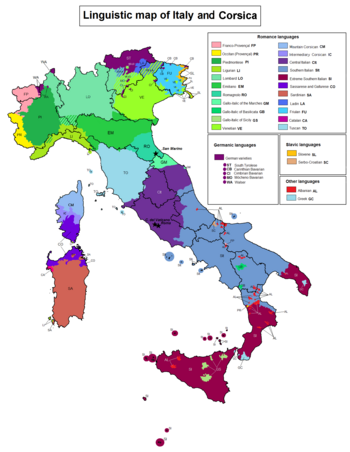Southern Italian
The southern Italian dialects (Italien. Italiano meridionale ) are a group of Romance dialects spoken in the southern part of the Apennine Peninsula and in Sicily .
Demarcation
The southern Italian dialects are separated in the north by the isogloss bundle Rome - Ancona from the central Italian dialects of Lazio , Umbria and the Marche , with which they are, however, often grouped together to form Central and Southern Italian (Italien. Italiano centro-meridionale ). The Central and Southern Italy as a whole is its part of Tuscany and the northern Italian dialects from the Galloitalischen and Venezischen exist, distinguished.
Within the southern Italian dialects, those of the extreme south ( italiano meridionale estremo ) are often distinguished from the rest.
The southern Italian dialects include Sicilian , Calabrian and Campanian, which also includes Neapolitan .
Like all other Romance languages, the southern Italian regional languages are derived from spoken Vulgar Latin . Together with Central Italian and Tuscan, as well as the Romance languages of the Balkan Peninsula, they belong to the group of Eastern Romance languages .
Characteristics
Independent of the different regional dialects of southern Italy, the following common characteristic features can be noted:
phonetics
- Syllable structure : consonant-vowel-consonant-vowel
This syllable structure is strictly adhered to, if two consonants meet, a vowel is inserted (anaptyx, see next point).
Insertion of an unetymological sound to preserve the syllable structure CVCVCV, cf. standard Italian tecnico but southern Italian. tec ë nico .
Metaphony is a regressive assimilation at a distance in which two sounds are adjusted to one another. Metaphony can be found in all Italian dialects except Tuscan. German also knows metaphony, it is often referred to as umlaut (German father / father , I drive / you drive ). In southern Italy, the final -i and -u cause the metaphonic process:
- if the original Latin -Ī, -Ŭ / ɛ / or / ɔ / precedes it, it becomes a diphthong: / iɛ / or / wɔ /, e.g. vlat. PORCŬ, PORCĪ "pig" / "pigs"> * pɔrcu / pɔrci > südit. puorchë / puorchë
- precede the original Latin -Ī, -Ŭ / e / or / o /, the metaphony creates / i / or / o /, e.g. NERU "black"> * neru > südit. nirë
Because in southern Italian (except in Sicilian and southern Calabrian as well as in the dialect of Salento) all unstressed final vowels become -ë [ə] (so-called swallow ), masculine and feminine adjective forms can only be distinguished by metaphony: BONU> buonë (metaphony with the final -u), but BONA> bonë (no metaphony here, because the final -a in Latin)
Intervocal occlusions are doubled: Südital. double "afterwards" instead of standardital. dopo
- Assimilation : mb> mm, nd> nn
Vulgar latate. MUNDU, PALUMBA "World", "Taube"> standardital. mondo , palomba but southern Italy . monno , palomma . According to the traditional view, it goes back to an Oscar substrate. This phenomenon only exists to a limited extent (or not at all) in Sicily and southern Calabria.
- Rhotazism : l> r or d> r
The change from l> r can be found in southern Italian as well as in Sardinian and Romanian (e.g. lat. SALE> romanian. Sare "salt"). Roman sordato for standardital. soldato , the phenomenon of change starts from Naples d> r, cf. lat. PEDE "foot"> Neapolitan pe r ë .
- Velarization from Latin -LL-
In many more southern dialects, a retroflex sound is created in which the tongue is rolled back: vlat. BELLU> siz. beddu [bɛɖɖu]. This phenomenon can also be found in Sardinian .
b> v and v> b
Morphosyntax
- Shortened infinitive: südital. avé for standardital. avere "have" (exception: Sicilian)
- Enclitic or postnominal possessive pronoun: Südital. fieta for Italian tua figlia "your daughter". This phenomenon is also found in Dalmatian and Romanian .
- Synthetic perfect as a narrative form: the passato remoto is used instead of the passato prossimo , the passato prossimo no longer exists.
- The definitive article is lu or o : from ILLU> südital. lu
- Konjunktionale Redundancy: as in most Romance languages popular all subordinate clauses with the conjunction che / ca highlighted.
- Retention of the ending of the Latin 1st Ps. Pl. Present tense (depending on the conjugation classes): südital. -amo, -emo, -imo for standardital. uniform -iamo .
- Prepositional accusative : Marking of the directly animate object with the preposition a (as in Spanish and Sardinian ): Sicilian vittu a Maria "I saw Maria" (cf. Italian vide Maria ).
Bibliography / Sources
- Corrado Grassi [et al.]: Introduzione alla dialettologia italiana . Rome: Laterza, 2003.
- Giacomo Devoto / Gabriella Giacomelli: I dialetti delle regioni d'Italia . Milan: Bompiani, 3rd edition, 2002.
- Carla Marcato: Dialetto, dialetti e italiano . Bologna: il Mulino, 2002.
- PE Guarnerio: Fonologia romanza . Milan: Hoepli, 2nd edition, 1978.
